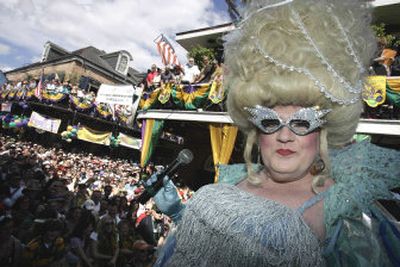Mardi Gras mood signals New Orleans’ resilience

NEW ORLEANS – For a few precious hours, old New Orleans was back. Elaborate floats streamed down Canal Street, brass bands blasted in the French Quarter, and Mardi Gras Indians chanted and danced in the neighborhoods Tuesday.
Even the ubiquitous Southern Comfort billboards announced the city’s defiant optimism: “Nothing cancels Mardi Gras. Nothing.”
To those who love this city, Mardi Gras 2006 was as much celebration as homecoming, a jubilant affirmation that not even the wrath of Hurricane Katrina could blow away the city’s age-old cultural traditions.
“This year Mardi Gras is all about feeling normal,” celebrated singer Charmaine Neville told the crowd Monday night at Snug Harbor, the city’s top jazz club. “It’s about people being back in my city again.”
If the turnout was unmistakably thinner than in years past, the revelers seemed to make up for that in high spirits and higher decibels. So intense was the crowd’s response, in fact, that visitors who just listened rather than watched might have believed nothing had changed since last year’s celebration. The wall-to-wall carpeting of brightly colored beads that covered Canal Street and St. Charles Avenue – the major parade routes – also attested to the fervency with which New Orleanians and visitors embraced the day.
“I was a little worried that people were going to be depressed,” said Cynthia Tucker of Boca Raton, Fla., who has celebrated Fat Tuesday here annually since 1988. “But they don’t seem to be. There’s a really celebratory mood.”
Still, Tucker and others noticed clear differences between this year’s bash and earlier incarnations.
“It’s a younger crowd – the elderly are missing,” she said. “The whole demographic has changed. And it’s a lot whiter.”
But away from the usual tourist spots – out in neighborhoods such as Treme, the central city and Uptown – the Mardi Gras Indians returned in full glory.
Many devotees of the city’s Indian subculture, a mixture of African American and Native American music and dance, wondered whether the spectacularly feathered costumes and ancient songs and chants would resurface this year. Much of this population group has been displaced across Texas, Mississippi, Alabama and other parts of the South and Southwest.
But by 7 a.m. Tuesday, it was clear that the Mardi Gras Indians were back with remarkable strength.
Congo Nation pounded drums, danced exuberantly and paraded a stuffed panther’s head through the streets of Treme, an area hard hit by the hurricane.
“No one knew how many of the Indians would come back,” said Joyce Jackson, a professor of ethnomusicology at Louisiana State University. “We are so happy to see they came out, even if it’s just for today.”
Many people thought this year’s event was dominated by locals rather than visitors. New Orleanians who previously stayed away from the tourist bash turned out in droves.